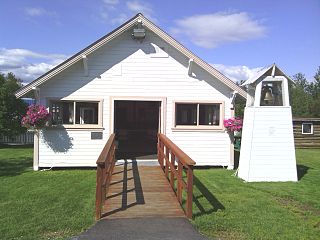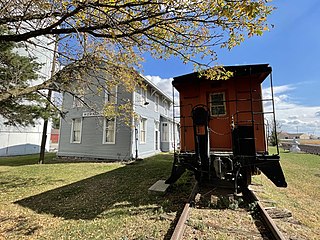
Klondike Gold Rush National Historical Park is a national historical park operated by the National Park Service that seeks to commemorate the Klondike Gold Rush of the late 1890s. Though the gold fields that were the ultimate goal of the stampeders lay in the Yukon Territory, the park comprises staging areas for the trek there and the routes leading in its direction. There are four units, including three in Municipality of Skagway Borough, Alaska and a fourth in the Pioneer Square National Historic District in Seattle, Washington.

The Chicago, Rock Island and Pacific Railroad Passenger Station is a historic building located in Iowa City, Iowa, United States. Built in 1898 for passenger use, it was the second depot in the city. The first one was built by the Mississippi and Missouri Railroad, a predecessor of the Chicago, Rock Island and Pacific Railroad (CRI&P), in 1855. This one was built through the efforts of Harry Breene, the local Rock Island agent. W.K. McFarlin, CRI&P's superintendent of maintenance and construction oversaw the building's construction. Architecturally, it is a combination of the Richardsonian Romanesque and Victorian Romanesque. The depot was built to similar designs of stations in Ottawa, Illinois, and Council Bluffs, Iowa.

Anchorage Depot, also known as Alaska Railroad Depot, is the railroad station at the center of the Alaska Railroad system at the junction of the two main lines their trains run on. It serves as the starting point for many tourists traveling on the luxury trains such as the Denali Star. The station is a Moderne-style three story concrete building, built in 1942 and enlarged in 1948.

The Seward Depot, also known as the Seward Station, is a former rail depot in Seward, Alaska, United States.

Grand Forks station is a property in Grand Forks, North Dakota, United States, that was listed on the National Register of Historic Places in 1982 as the Northern Pacific Depot and Freight House. It was used both as a passenger station and a freight warehouse/depot by the Northern Pacific Railway.

The Alaskan Engineering Commission (AEC) was a U.S. Federal agency, sometimes known by its initials or by alternate spelling Alaska Engineering Commission. It was created by the Alaska Railroad Act in 1914 by U.S. President Woodrow Wilson in order to arrange for the construction of a railway system in Alaska. William C. Edes was named chairman, chief engineer Colonel Frederick Mears. In 1915, the AEC became part of the U.S. Department of the Interior. In 1923, after the railroad began operation and construction was complete, it became the Alaska Railroad Commission, later renamed to The Alaska Railroad.
The Whitney Section House, also known as Whitney Station, is a historic railroad-related building in Wasilla, Alaska. It is a single-story wood-frame structure, which was built in 1917 by the Alaska Railroad. It originally stood at mile 119.1, about 4.8 miles (7.7 km) north of Anchorage Station, and was one of a series built by the railroad and located at roughly ten-mile intervals. The area where it stood was taken by the federal government for Elmendorf Air Force Base, and was rescued from demolition by the local chapter of the National Railroad Historical Society. It now stands on the grounds of the Alaska Museum of Transportation and Industry in Wasilla, and has seen a variety of uses.

Mayville station is a historic train station on Front St. in Mayville, North Dakota. It was built in 1897. It was listed on the National Register of Historic Places in 1977 as the Great Northern Railway Depot.

The Brooks River Historic Ranger Station is a log structure located at Brooks Camp in Katmai National Park and Preserve, located on the Alaska Peninsula of southwestern Alaska. It is a single-story building, made out of peeled logs felled in 1954 and assembled in 1955. The building was the first structure built by the National Park Service in Katmai National Park. It was built in part to oversee the growing Brooks Camp facility, which had been built over time by tourism concessionaires.

The Nenana Depot, located at 900 A Street in Nenana, Alaska, is an Alaska Railroad depot built in 1922. The station served an extension of the railroad which was laid in 1916. An addition was placed on the station in 1937 to house the station agent. The station has served both as an important part of the railroad's northern operations and as a terminal for its riverboat service on the Yukon River. It was listed on the National Register of Historic Places in 1977.

The Wasilla Elementary School, located near the corner of East Swanson Avenue and North Boundary Street in Wasilla, Alaska is a historic one-room school that was built in 1917. It was Wasilla's first school, and served as its primary school until 1934 when a larger school was built. It is 22 by 36 feet in dimension. It was moved to its present location, in a historic park, shortly before its NRHP nomination in 1979. It had been located about three blocks away. After 1934 it was used again as a school overflow classroom and it also served as a community hall and for weddings, funerals and other events; it served as a Church of Christ for a number of years.
The Wasilla Community Hall, also known as the Wasilla Museum, now hosting the Dorothy G. Page Museum, is located at 323 Main Street in Wasilla, Alaska. The museum is located in a log building constructed in 1931 to serve as a community center. The exterior of the building was left largely as-is when it was converted to a museum in 1967. The interior houses displays about the history of the city of Wasilla.

The Independence Mines, now Independence Mine State Historic Park, is the site of a former gold mining operation in the Talkeetna Mountains, across Hatcher Pass from Palmer, Alaska. The area's mining history dates to at least 1897, when active claims were reported in the vicinity of Fishook Creek. These early mining efforts were eventually joined to form the Wasilla Mining Company, which worked the mines from 1934 to 1943, and again from 1948 to 1950. The mining operation at Independence was the second-largest hard-rock gold mining operation in the state, after a larger site near Juneau. The company and the miners that preceded it built a substantial mining camp, with as many as sixteen wood-frame buildings, which were originally connected to each other by sheltered wooden "tunnels". When the company ended operations in 1950, it had expected to eventually resume operations, but never did; this resulted in a particularly well-preserved collection of mining equipment and buildings, although the weather has since taken a significant toll on the latter.

The Knik Site, also known as the Old Knik Townsite, is the location in Matanuska-Susitna Borough, Alaska that was once home to the largest settlement on Cook Inlet. The only surviving remnants of the community are a former log roadhouse, now a museum operated by the Wasilla-Knik Historical Society, and a log cabin. The Knik area had long been a meeting point of Native Alaskans, and in 1898 it became the principal community on Cook Inlet from which goods were shipped into the interior. In 1916 the Alaska Railroad reached the site of present-day Anchorage, bypassing Knik and leading to Anchorage's growth. When the railroad reached Wasilla, Knik lost all importance as a transshipment point, and its buildings were either abandoned or moved to one of the other communities. Knik is located about 13 miles (21 km) southwest of Wasilla.
The Blanche and Oscar Tryck House is a historic house on North Knik Street in Wasilla, Alaska. Built sometime before 1916 at Knik, it was the first house in Wasilla when the community was established, moved there by the Trycks in 1917. It is a single-story wood-frame structure, roughly rectangular in shape, with a concrete foundation and a corrugated metal gable roof configured to capture rainwater for laundry and other uses. It has a brick chimney and a root cellar, and has been vacant since Oscar Tryck died in 1964.

Teeland's Country Store, also known as Herning's Place and Knik Trading Company, is a historic retail establishment located at the corner of East Herning Avenue and North Boundary Street in Wasilla, Alaska. The oldest portion of this wood-frame building is a log structure at the back whose construction dates to 1905. Originally located at Knik, this log structure, then also used as a store, was moved to the newly established town of Wasilla in 1917 by its builder, O. G. Herning. Herning also built the present utilitarian wood-frame structure, which still operates today. The business was purchased by Walter Teeland in 1947, giving it its present name. In 1972 the store was purchased by Jules and Leslie Mead and Neil Gail Bridgewater.

The Palmer Depot is a historic train station at South Valley Way and Evergreen Avenue in Palmer, Alaska. It is a large three-section single story frame structure, built in 1935 to provide transportation services to the newly established Matanuska Valley Colony. The main section is the former warehouse, which is 94 feet (29 m) long. The next section, with a lower profile than the warehouse, housed baggage facilities, a passenger waiting area, and living quarters for the station agent. The third section, the smallest of the three, houses the former ticketing office. The building now houses a community center.
P. C. C. & St. L. Railroad Freight Depot, also known as the Central Union Warehouse, was a historic freight depot located at Indianapolis, Marion County, Indiana. It was built in 1916 by the Pittsburgh, Cincinnati, Chicago and St. Louis Railroad. It was a one-story, brick warehouse building measuring 790 feet long and 70 feet wide. It has been demolished.

The Chicago, Milwaukee, St. Paul & Pacific Combination Depot-Hornick, also known as the Hornick Depot, is a historic building located in Hornick, Iowa, United States. The town was patted by the Chicago, Milwaukee, St. Paul & Pacific Railroad's land company when the railroad created a branch line from Manilla, Iowa to Sioux City. Completed in 1887, the railroad built this two-story frame structure to serve as its passenger and freight depot. It is one of six such depots that remain in Iowa, and the best preserved. These buildings were built from a standard design used by the railroad. The two-story stations included living quarters for the station manager because the towns had yet to develop when the depot was built. This was an island depot, with freight loaded on the north side and passengers boarded on the south. Decorative elements on this depot include lathe-turned wooden finials, angled wooden brackets, and bracketed door and window hoods. Passenger service ended in the 1950s, and grain was loaded here until 1980 when the Milwaukee Road abandoned the Sioux City branch line. The building was listed on the National Register of Historic Places in 1990. It has been converted into a local history museum.

Cunningham-Hall PT-6 NC692W is one of two surviving aircraft of its type from the early days of aviation in the history of Alaska. The Cunningham-Hall PT-6 is a single-engine six-seat cabin biplane built by the Cunningham-Hall Aircraft Corporation, which was designed mainly as a personal transport. The aircraft, registered as NC692W, with c/n. 2962, was built in 1930 and is the second of its kind constructed. It was entirely rebuilt as a static display using non-airworthy materials in the 1970s.



















